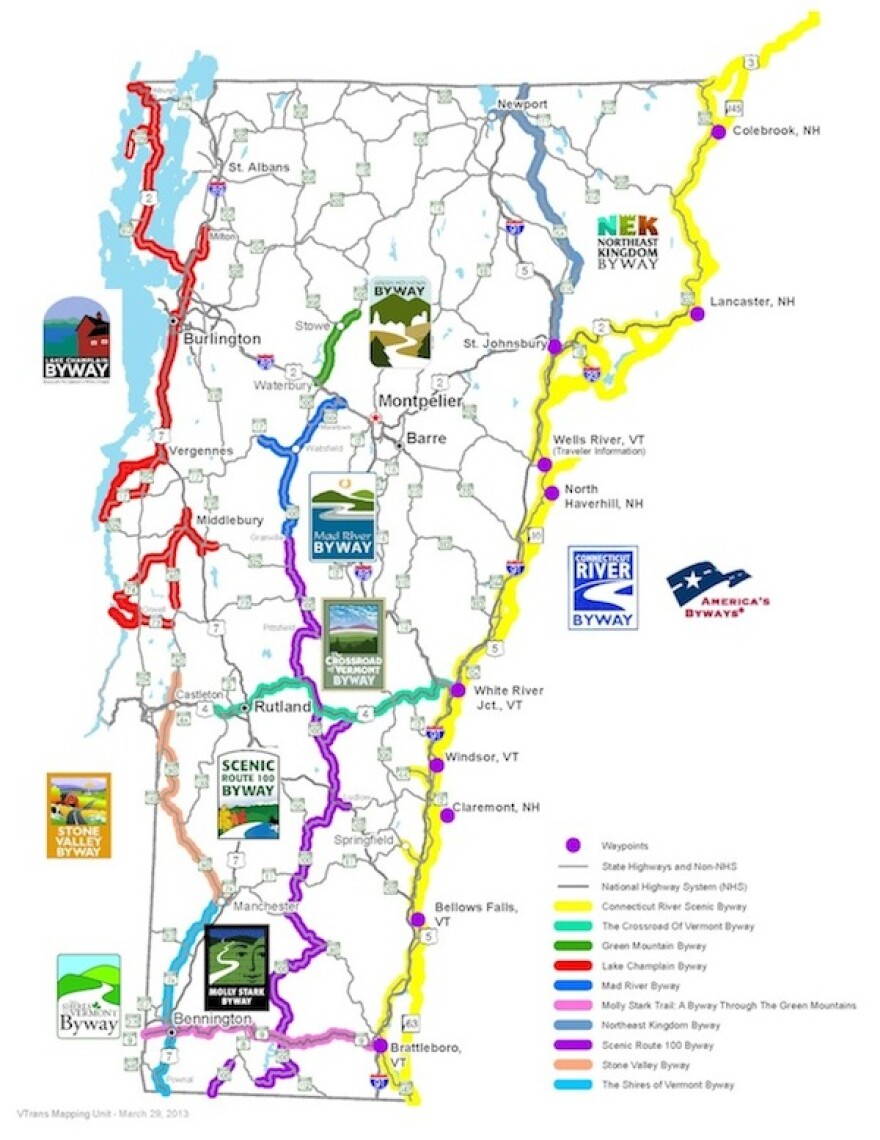Last week the Vermont Transportation Board officially expanded the Scenic Route 100 Byway to encompass 138 miles through 20 towns in central and southern Vermont. To be clear, Route 100 hasn't changed, just the "byway" designation has been expanded to new portions of the road. So, why are so many towns and businesses along the route so excited? It's all about marketing.
The push to expand the byway came from regional planning commissions and chambers of commerce along the route, representing towns and businesses along the way. Among them is the Southern Windsor County Regional Planning Commission, which posted the following on its website:
The Scenic Route 100 Byway was originally designated on April 20, 2011, as the 8th Vermont Byway and was officially extended on April 18, 2013. It is now Vermont’s second largest Byway at 138 miles, behind the Connecticut River Byway, crisscrossing along the spine of the Green Mountains from the Mad River Byway to the Massachusetts’s border. The Byway includes Route 100 and small sections of 100A and 103 through the towns of Granville, Hancock, Rochester, Stockbridge, Pittsfield, Killington, Bridgewater, Plymouth, Ludlow, Andover, Cavendish, Weston, Londonderry, Jamaica, Wardsboro, Stratton, Dover, Wilmington, Whitingham and Stamford.
So what is a scenic byway? And why does it matter? Simply put, the byway designation creates an entity with its own bylaws, management plan and a governing byway committee. The committee is made up of local business people and representatives from the municipalities, chambers of commerce and regional planning commissions along the route.
Each community contributes its own itinerary for the byway, listing places to go and things to do along the route. John Zicconi, executive secretary for the Vermont Transportation Board, noted such attractions needn't be exactly on the designated roadway, but are within the byway "corridor" that stretches several miles on either side of the road.
Strung together, the itineraries can be used to create regional marketing opportunities and aid visitors in vacation planning. They can be used to promote tourism, such as this passage from the Okemo Valley website:
Recognized by Yankee Magazine as one of “the most scenic drives in New England” and part of Vermont’s “Skiers Highway,” which connects some of the best skiing and riding opportunities in the Northeast, this byway connects three of the region’s best golf courses, along with extraordinary lakes for fishing, boating and swimming, impressive mountains for hiking and biking with an interesting network of roads which are popular with cyclists. The corridor begins in Andover then travels to Ludlow where it connects with VT Route 103 and Scenic Route 131. Here you’ll find the oldest arts and crafts schools in the country, Fletcher Farm School for the Arts and Crafts, and the Black River Academy Museum where Calvin Coolidge went to school. The Byway continues on Route 100 in Plymouth to Route 100a in Plymouth Notch where you’ll find President Calvin Coolidge State Historic site, home to the Summer White House of the 30th President of the United States, Calvin Coolidge, and what is considered one of the best preserved Presidential sites in the nation. Today, Plymouth Notch remains a pristine example of an early 20th century Vermont hill town and a visit here is well worth your journey before heading on to Bridgewater, Killington and Pittsfield where this byway connects with the Crossroad of Vermont Byway.
Zicconi explained byways don't necessarily need to be scenic, either. The Vermont Transportation Board makes its decision to designate a byway based upon a half-dozen federally prescribed criteria, and a roadway only needs to satisfy one on the six. However, Zicconi noted, most of Vermont's byways qualify on multiple fronts. The qualifying categories are: scenic, historic, cultural, archeological, recreational and natural.
The newly expanded Scenic Route 100 Byway stretches from the Massachusetts border up to Granville, although Route 100 continues north to the Canadian boarder. In fact there are two other designated byways along the northern half of Route 100. Where the Scenic Route 100 Byway leaves off in Granville, the Mad River Byway begins. The Mad River Byway veers off of Route 100 in Moretown, following Route 100B. Yet just up the road in Waterbury, Route 100 becomes the Green Mountain Byway, which runs through Waterbury and Stowe. The Green Mountain Byway is the shortest byway in the state.
Check out the State's Explore Vermont's Byways website for videos and maps of all the official byways throughout Vermont.





